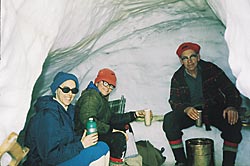Sandpoint on Ice
caving & climbing
Snug. Cozy. Warm. Those are hardly images associated with snow and ice. The way Ray Matz tells it, though, that’s exactly what he and his hiking partner were one stormy day high on Schweitzer Mountain last winter. For that matter, so was the dog.
A tremor of anxiety had rippled down Ray’s spine, and he felt compelled to check on his canine friend. Pushing a barricade aside, he peered upon a landscape smothered in a blizzard’s fury, and beneath a blanket of swirling snow the dog was lying comfortably, not an ounce of worry on its sleepy face. It snuggled back under the frosty layers accumulating on its back. Matz returned to the dim light of the cave.
It was a snow cave, and with the help of a candle and the two men’s body heat, the cave, though encased in glistening ice, was snug, cozy and warm.
Snow caving, says Matz, “is way better than tent camping in the winter.” It’s an activity he has pursued for almost 30 years. He was introduced to it by a man known locally as “the grandfather of snow caves,” the late Russell Keene.
Ray and his wife, Doris, encountered Keene with his young son Rob on the snowy slopes of Schweitzer in 1974, and a close friendship was struck. “He taught us how to snow cave,” Ray said. The value of a snow cave on a harsh, northern Idaho’s winter day can’t be overstated, but creating one involves a great deal of work. Last winter’s cave required three hours of effort by three men. Once the 8-by-8-foot room is hollowed out of a suitable drift or tree well, however, routine maintenance will keep it safe and usable for an entire season.
Wet. Cold. Blue. Those are hardly images associated with rock climbing. The way Tom Helmbrecht tells it, though, that’s how it can be when rock is covered in ice. Tom and his 17-year old son, Aaron, began technical rock climbing 10 years ago under the tutelage of Tom’s nephew, Don.
During the winter of 1999, however, when driving Highway 2 to Libby, “I saw someone climbing the ice on some cliffs,” Tom recalls, “and I said to myself, it looks a lot the same.” Almost immediately he converted his rock climbing gear to ice climbing equipment. “It’s a lot easier on me and just as safe,” he maintains. Aaron isn’t quite so convinced. “I don’t think you can trust it,” he said. “It’s a seasonal thing.”
It may be seasonal, but Tom feels ice, when read correctly, is anything but untrustworthy. Drive an ice axe deep, secure the teeth of your boots’ crampons on the frozen surface, and “you wouldn’t believe how secure you feel,” he exclaimed. So how do father and son coordinate their different climbing interests? “Aaron belays for me in my sport and I belay for him in his sport,” Tom explained.
 |
 |
|
Top right: An ice climber scales Copper Falls. Above: Russell Keene, right, his son Rob and Doris Matz snow caving on Schweitzer in 1974. (Photo by Ray Matz)
|
|
Finding good ice is tricky in western Montana and northern Idaho. It’s not always cold enough. The best ice climbing he has found, Tom says, is at Copper Falls northeast of Bonners Ferry. In fact, an article in The River Journal a couple of years ago turned him onto Copper Falls and its blue ice – a sign the ice is strong and climbable.
Ice provides a great excuse to get outside during the winter, whether hunkered securely against a raging blizzard in a snow cave or dangling precariously from an adze tightly wedged into a crack in a frozen waterfall.
- By Dennis Nicholls
|